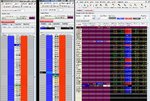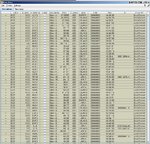evostik said:
Thanks for that Grey1. I really want to try and understand properly. Can I paint an example picture to see if I am starting to grasp it?....
So, using the 1% of account 'rule' you have described before, lets say we have $1000 to "go shopping".
We are trading on the 1,3 and 5 minute time frame analysis.
Lets say the 1 minute ATR of stock A is 10c
Lets say the 3 minute ATR of stock A is 30c
Lets say the 5 minute ATR of stock A is 50c
So, one can afford to $1000 divided by 50c = 2000 shares?
So, market is strong (+50?) and stock is strong (+ve from open?)
We then get (using your MACCI engine) OS in each of three time-frames (DOW or stock or both? still unsure here?).
We therefore buy 2000 shares of stock A.
However, if price continues to fall by another 10C then we sell one fifth (10c/50c) of the shares = sell 400 shares.
If price fall by another 20c (by total 30c) we sell another 800 shares.
If price falls by another 20c (total 50c fall) we sell remainder (800 shares).
Does this make sense, Grey1? Is my understanding getting close to this aspect of your teaching?
I hope you have time to reply and correct me where necessary.
Thanks as always,
Steve
That is not correct my man . You cannot dump the same number of shares, you need to dump the number of shares equivalent to the volatility as follow
Number of shares= $1000/10 = 10 000 shares for 1 min time frame
Number of shares = 1000/20 = 5000 shares for 3 min time frame
Number of shares = $ $1000/50 = 2000 shares for 5 min time frame
You get a confirmation signal in three time frames lets say BUY , BUY , BUY
You open a position of 10 000 stock X .. Trade goes against you on the 1 min time frame you then dump ( 10 000 -5000 )= 5000 shares of the stock X
Now the 3 min goes against you then dump ( 5000-2000) = 3000 shares of the stock X
Now the 5 min goes against you ,,,, You close the position . i.e you dump the rest
Now lets try another scenario,,
what if 1 min goes against you and you dumped 5000 and then stock moved in ur direction what next ? easy ,, we add what we dumped before to have 10 000 to be in full force.
This is dynamic risk analysis and can be coded in radar in two min .
Of course the $1000 shopping can be reduce to $500 or less
grey1



